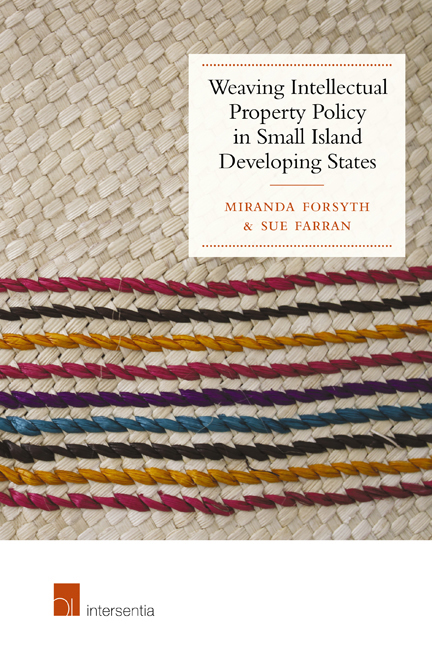Book contents
- Frontmatter
- Dedication
- Acknowledgements
- Contents
- List of Tables
- Introduction
- Chapter 1 Intellectual Property and Development: The Issues Viewed through a Pacific Islands Prism
- Chapter 2 Health and Issues of Access to Medicine
- Chapter 3 Access to Educational Resources
- Chapter 4 Problems with Importing the Global Intellectual Property Regime into Pacific Island Countries: Learning from Land
- Chapter 5 Setting Out a New Approach to Intellectual Property and Development
- Chapter 6 Intellectual Property and Technological Innovation in Pacific Island Countries: The Example of Sustainable Sea Transport
- Chapter 7 Branding, Certifying and Authenticating in Pacific Island Countries
- Chapter 8 The Regulation of Traditional Medicinal Knowledge in Pacific Island Countries
- Conclusion
- About the Authors
Chapter 7 - Branding, Certifying and Authenticating in Pacific Island Countries
Published online by Cambridge University Press: 22 November 2017
- Frontmatter
- Dedication
- Acknowledgements
- Contents
- List of Tables
- Introduction
- Chapter 1 Intellectual Property and Development: The Issues Viewed through a Pacific Islands Prism
- Chapter 2 Health and Issues of Access to Medicine
- Chapter 3 Access to Educational Resources
- Chapter 4 Problems with Importing the Global Intellectual Property Regime into Pacific Island Countries: Learning from Land
- Chapter 5 Setting Out a New Approach to Intellectual Property and Development
- Chapter 6 Intellectual Property and Technological Innovation in Pacific Island Countries: The Example of Sustainable Sea Transport
- Chapter 7 Branding, Certifying and Authenticating in Pacific Island Countries
- Chapter 8 The Regulation of Traditional Medicinal Knowledge in Pacific Island Countries
- Conclusion
- About the Authors
Summary
INTRODUCTION
The previous chapter discussed the way in which adopting a more pluralistic approach to intellectual property regulation in the context of technological innovation opens up new pathways and possibilities. In this chapter we explore another important aspect of intellectual property for developing countries, namely branding and culture- or place-based products and industries. As well as considering global forms of intellectual property such as trademarks and geographical indications of origin (GIs), we also explore locally modified mechanisms such as Fiji's experiments with a new batch of authenticity marks, a new regional organic standard and an ambitious move away from third-party certification to a participatory certification scheme. We discuss the complex issues the interplay between cultural heritage and intellectual property regulation raises for the region, both in terms of the desire to stop misappropriation of traditional knowledge by ‘outsiders’ and to facilitate its commercialisation by ‘insiders’, at the same time highlighting the problematic nature of such binaries. The various case studies and examples discussed in this chapter provide insights into the different strands of regulation that are available in this space and the benefits of engaging constructively with them. The chapter is structured around the exploration of how a range of different intellectual property mechanisms -trademarks, global certification schemes, labels of authenticity, GIs, collective marks, customary protocols, education and negative publicity - are currently being used in the Pacific islands region, with a particular emphasis on Fiji as it has been the most active in this area to date.
TRADEMARKS
Trademarks are the most well-established of all the different types of global intellectual property rights in the region and all Pacific island countries have trademark legislation of one form or another. In essence, trademarks constitute words, symbols or devices which, in the form of an outward and recognisable representation placed on products, help consumers to identify their origins. Trademarks have the potential to fulfil a number of different policy objectives: allowing producers of goods and services to protect their investment in quality, building up of a reputation, aiding in advertising of products, and assisting consumers in assessing the quality and source of products. As businesses in the region become more complex, they are more likely to want to be able to stop competitors from ‘free-riding’ on these investments and indeed trademark disputes are those most commonly coming before the courts.
- Type
- Chapter
- Information
- Publisher: IntersentiaPrint publication year: 2015



